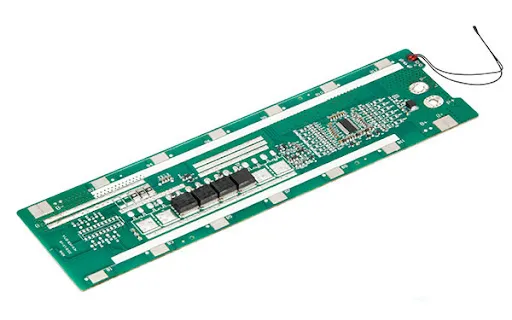With the rapid development of power lithium batteries, there have been significant breakthroughs in production processes, material technology, and price advantages. This lays a solid foundation for the widespread adoption of lithium batteries, particularly in areas like electric bicycles and backup power supplies. As the market share of lithium batteries grows, ensuring their safety and extending their service life becomes crucial. One core component in battery packs that contributes to this goal is the protection board.

The Complexity of Power Battery Protection Boards
Although the theoretical design of a multi-string battery protection board might seem simple, the real challenge lies in ensuring that it is stable, reliable, and safe while being cost-effective. Effective protection can only be achieved through a combination of technology and experience. In fact, when it comes to power battery protection, experience plays a far greater role than technical knowledge. A well-designed protection board requires extensive hands-on experience—typically three to five years in the field.
The protection board must ensure that the battery pack operates safely under various conditions. While the protection board's design is not overly complicated, ensuring its longevity and performance under high voltage, high current, and challenging working environments requires a deep understanding of battery systems.
Key Protection Features
1. Voltage Protection:The protection board must guard against overcharging and over-discharging. Overcharge protection, for example, ensures that the battery is not charged above its safe voltage threshold, usually around 4.18-4.2V for manganese lithium batteries. Over-discharging protection ensures the battery is not drained below its critical voltage, typically between 2.8V and 3.0V for manganese lithium batteries. Adjusting protection voltage points based on battery material and usage scenarios is crucial to extending battery life.
2. Current Protection:Overcurrent protection is essential to prevent damage from excessive current. This is achieved by disconnecting the switch MOS when the current exceeds a certain threshold. The MOS tube's power dissipation must be carefully calculated to avoid overheating. Additionally, overcurrent protection settings need to account for varying loads and device types, such as electric tools, which draw higher current at startup.
3. Short Circuit Protection:Short-circuit protection is typically implemented through voltage comparison, automatically shutting down the battery pack or disconnecting the load. The timing of this protection must be carefully adjusted to prevent unnecessary disconnections when the input filter capacitor charges during initial contact.
4. Temperature Protection:Temperature sensors on smart batteries provide an additional layer of safety. The protection board can disconnect the battery or load if the temperature exceeds a safe threshold, though temperature variations based on geographic location and environmental conditions can complicate these settings.
5. MOS Protection:The MOS tube's voltage, current, and temperature must be carefully monitored to avoid overheating. A well-designed protection board ensures that the MOS tube's driving current is sufficient to prevent temperature rise, especially when dealing with high-current loads. In some cases, multiple stages of drive control are required to ensure proper operation when current exceeds 50A.
Equalization Methods: Energy Consumption vs. Energy Transfer
Energy Consumption Equalization:This method uses resistors to dissipate excess energy from higher-voltage batteries. There are three common types of energy consumption equalization:
Charging Equalization: Initiated when the voltage of any battery exceeds the average voltage of all cells during charging. This method provides more time to balance the voltage but can lead to inefficient energy use.
Voltage Fixed-Point Equalization: This starts when a battery's voltage reaches a specific threshold, like 4.2V for manganese lithium batteries, but it is only effective at the end of the charging cycle.
Static Automatic Equalization: Equalization occurs during charging, discharging, or when batteries are in storage. While this method can help address voltage inconsistency, it can generate excessive heat, which is detrimental to battery life.
While energy consumption equalization is simple and inexpensive, it has significant downsides. The heat generated during the balancing process can be harmful to the battery, causing faster aging. This method may also lead to unequal wear across batteries in the pack, especially if there are variations in battery capacity.
Energy Transfer Equalization:This method transfers energy from larger-capacity cells to smaller ones through energy storage, aiming to equalize the overall capacity of the battery pack. While this approach sounds efficient, it comes with challenges. For example, a small battery may reach its full voltage before larger batteries, leading to overcharging and faster aging.
The Role of Experience in Protection Board Design
The balance between theory and practice is vital in the design of protection boards. While theoretical equalization methods may sound promising, their practical application often leads to inefficiencies or failures in real-world scenarios. In mass production, balancing methods, particularly energy consumption equalization, can result in significant losses due to excessive heat and poor performance. Therefore, it’s crucial to prioritize battery consistency over balancing methods.
The protection board’s primary role is not to enhance battery performance but to ensure that the battery operates safely in extreme conditions. Just as a fuse in a home appliance doesn't improve the appliance’s performance but only protects it in case of failure, a battery protection board does not enhance the battery’s capacity but rather safeguards it from damage during extreme events like overcharging, overdischarging, and short circuits.
Conclusion
In conclusion, while power battery protection boards play a critical role in ensuring the safety and longevity of lithium battery packs, their design requires careful consideration of various factors, including voltage, current, temperature, and MOS protection. Additionally, balancing methods should be used cautiously, as they can have negative consequences on battery life and efficiency. Experience is paramount in designing effective protection boards, and mass production of power battery protection boards requires not only technical expertise but also a deep understanding of the complexities of battery systems.



